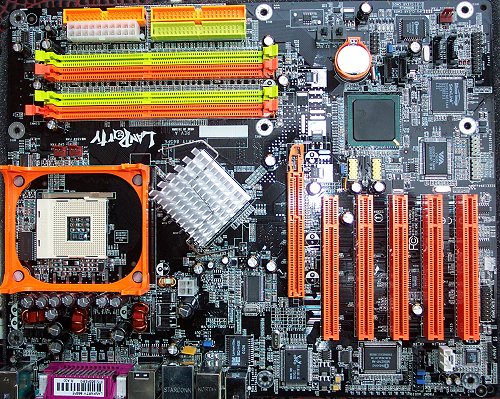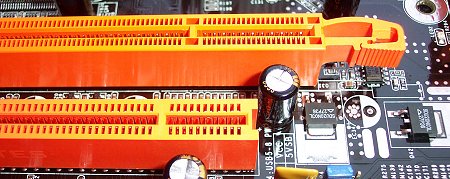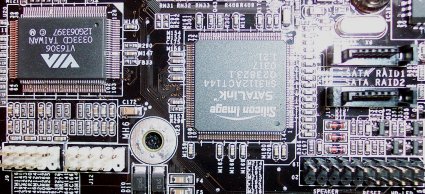Layout and Features

Depending upon your disposition, it's either a pretty or garish-looking motherboard. Lots of orange and lime purport to go for the colour jugular. Are looks important on a motherboard these days ?. The answer to that question is probably yes. It's kind of obvious that most boards based on a single chipset will return similar performance. We also expect most feature-laden boards to use similar components, and we've also witnessed a steady rise in stability from 'lesser' manufacturers. There's literally nothing to differentiate, say, an ASUS to a Biostar board in most respects. That's why DFI has chosen to do away with standard colouring and go for a very distinctive colour scheme.
It also helps mattes that the ports, DIMM slots and retention bracket are all reactive to Ultra Violet light. Cold Cathodes have become popular amongst enthusiasts, so DFI is aiming at a broad a church as possible here.

Power is regulated via a 3-phase design. The retention bracket is obscured by the huge heatsink placed on the i865PE MCH. We like the fact that it's passive in design, but we feel that its extremity is a little too close to the retention bracket. DFI helps matters by ensuring that CPU heatsinks attach in a way that doesn't interfere with the N.B's heatsink. The bracket itself is surrounded by two fan headers and the 3-phase power design. It's nice to see the two headers slightly away from the outer edges of the bracket. Too many designs have them crammed right next door.

Little touches are what makes a motherboard's layout decent. DFI has the floppy and main 20-pin power connector's locks facing in opposite directions. That means you don't have to mess about trying to remove one or the other. There's also enough room between the two PATA ports for easy installation and removal. We had hoped that the DIMM slots would have been moved closer to the edge of the PCB. That would allow system RAM to be removed without having to tamper with the AGP card, and we'd have liked it better if the 4-pin power connector was closer to the main 20-pin one.

The 8x AGP port uses a non-standard form of locking the card to the board. There's an extra plastic piece that has to be moved sideways for the card to be removed. It works well, though. Like most motherboards, the first PCI slot is too close the AGP, such that adding in a card here would compromise the GPU fan's airflow. We'd like a double-sized gap between these two. 5 standard PCI slots are available and two USB2.0 headers fit in to the right of slots 2 and 3.

One apparent letdown here is the ICH5 (non-R) Southbridge. It only offers independent running of SATA drives, one on each port. DFI makes up for it a bit further down the board. We like the reset and power buttons on the PCB itself. Handy for testing with. However, we'd like an ABIT-style jumper for resetting CMOS. The blue one, supplied here, is a bit fiddly to get to and manipulate. Located at the bottom-right of the above shot and hard to see are 4 LEDs that act as elementary troubleshooting devices during the POST sequence. Holdups can be cross-referenced with the manual.

The ubiquitous Silicon Image Sil3112A PCI SATA RAID controller adds a further 2 ports that can be run in independent, RAID0 and RAID1 modes. We recently looked at DFI's NFII Ultra Rev. B board. It boasted the newer 4-port controller from Silicon Image. We must note that this is a Revision A board with a BIOS dated 08/08/03. Therefore, we'll probably see a makeover in the not too distant future. VIA's 3-port FireWire controller sits to the left and two ports can be connected up via the headers underneath. The layout of the lower section is good. Realtek's Gigabit LAN and CMI's 9739A 6-channel sound CODEC help boost the 865PE's credentials to the deluxe level.

We like coaxial input and output for S/PDIF operations. 4 USB2.0 ports are handy and the remaining available FireWire port is there, too. It's a decent board with thoughtful component location for the most part. Not the best we've seen here at HEXUS but far, far from the worst.. UV-reactive ports add a defining touch to an impressive package.









